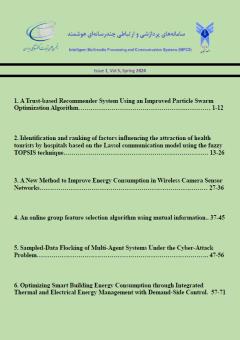بهینه سازی مصرف انرژی ساختمان هوشمند از طریق مدیریت یکپارچه انرژی حرارتی و الکتریکی با کنترل سمت تقاضا
الموضوعات : Multimedia Processing, Communications Systems, Intelligent Systemsعلیرضا مرادی 1 , سید محمدرضا هاشمی 2 , مریم فریدپور 3
1 - استادیار، گروه مهندسی برق، واحد مهدیشهر، دانشگاه آزاد اسلامی، مهدیشهر، ایران
2 - دکترا، گروه مهندسی کامپیوتر، دانشگاه ملی مهارت، تهران، ایران
3 - کارشناسی ارشد، گروه مهندسی کامپیوتر، دانشگاه ملی مهارت، تهران، ایران
الکلمات المفتاحية: مدیریت همزمان انرژی, ساختمان هوشمند, YALMIP, سیستم فتوولتائیک, بویلر, CHP.,
ملخص المقالة :
ساختمانهای هوشمند مجهز به زیرساختهای ارتباطی و کنترلی، پتانسیل بهینهسازی مدیریت انرژی را ارائه میدهند که منجر به افزایش بهرهوری و کاهش قابل توجه هزینهها میشود. این ساختمان ها معمولاً از چندین واحد مسکونی با وسایل برقی رایج مانند ماشین لباسشویی و تلویزیون تشکیل شده اند. سیستم مدیریت انرژی نه تنها باید نیازهای الکتریکی را تأمین کند، بلکه باید انرژی حرارتی را برای گرمایش و سرویس بهداشتی نیز تأمین کند. ساختمانهای هوشمند مدرن اغلب منابع انرژی مختلف مانند سیستمهای فتوولتائیک، واحدهای حرارتی و برق ترکیبی (CHP)، بویلرها، در کنار دستگاههای ذخیرهسازی الکتریکی و حرارتی را ادغام میکنند. یک چالش کلیدی در این زمینه، مدیریت هماهنگ انرژی حرارتی و الکتریکی برای به حداقل رساندن هزینه های عملیاتی ساختمان است. این مقاله یک مدل جامع برای این منظور پیشنهادمی کند. این مدل برنامهریزی انعطافپذیر تجهیزات الکتریکی مانند جاروبرقی را به همراه عملکرد دیگ بخار، واحد CHP و دستگاههای ذخیرهسازی درنظرمیگیرد که هدف همگی آن ها به حداقل رساندن هزینههای انرژی است. این مدل تضمین می کند که تمام خروجی سیستم فتوولتائیک در داخل ساختمان مصرف می شود و تمام نیازهای حرارتی و الکتریکی بدون حذف بار به طور مؤثر برآورده می شود. مدل محدّب، امکان یافتن راه حل بهینۀ سراسری را با استفاده از جعبه ابزار YALMIP و حل کننده های ریاضی مانند CPLEX می دهد. برای اعتبارسنجی مدل، یک ساختمان هوشمند شبیه سازی شده در MATLAB ایجادشد که در آن مدل پیشنهادی با دو الگوریتم ازدحام ذرات و YALMIP حل شد. نتایج نشان دهنده برتری YALMIP در یافتن راه حل بهینه است.
[1] M. Majidi, B. Mohammadi-Ivatloo, and A. Anvari-Moghaddam, "Optimal robust operation of combined heat and power systems with demand response programs," Applied Thermal Engineering, vol. 149, pp. 1359-1369, 2019.
[2] A. Yıldız, "Predicting the energy production of a rooftop pv plant by using differential evolution algorithm," Turkish Journal of Engineering (TUJE), vol. 3, pp. 106-109, 2019.
[3] D. Zhang, S. Evangelisti, P. Lettieri, and L. G. Papageorgiou, "Economic and environmental scheduling of smarthomes with microgrid: DER operation and electrical tasks," Energy conversion and management, vol. 110, pp. 113-124, 2016.
[4] M. Daneshvar, M. Pesaran, and B. Mohammadi-ivatloo, "Transactive energy in future smart homes," in The Energy Internet, ed: Elsevier, 2019, pp. 153-179.
[5] M. B. Rasheed, N. Javaid, M. S. A. Malik, M. Asif, M. K. Hanif, and M. H. Chaudary, "Intelligent multi-agent based multilayered control system for opportunistic load scheduling in smart buildings," IEEE Access, vol. 7, pp. 23990-24006, 2019.
[6] S. Yilmaz, J. Chambers, and M. Patel, "Comparison of clustering approaches for domestic electricity load profile characterisation-Implications for demand side management," Energy, vol. 180, pp. 665-677, 2019.
[7] C. Sijie and L. Chen-Ching, "From demand response to transactive energy: state of the art," Journal of Modern Power Systems and Clean Energy, vol. 5, pp. 10-19, 2017.
[8] D. Zhang, N. Shah, and L. G. Papageorgiou, "Efficient energy consumption and operation management in a smart building with microgrid," Energy Conversion and Management, vol. 74, pp. 209-222, 2013.
[9] M. L. Tuballa and M. L. Abundo, "A review of the development of Smart Grid technologies," Renewable and Sustainable Energy Reviews, vol. 59, pp. 710-725, 2016.
[10] J.-Y. Joo and M. D. Ilić, "An information exchange framework utilizing smart buildings for efficient microgrid operation," Proceedings of the IEEE, vol. 104, pp. 858-864, 2016.
[11] S. Kakran and S. Chanana, "Smart operations of smart grids integrated with distributed generation: A review," Renewable and Sustainable Energy Reviews, vol. 81, pp. 524-535, 2018.
[12] O. Erdinc, N. G. Paterakis, T. D. Mendes, A. G. Bakirtzis, and J. P. Catalão, "Smart household operation considering bi-directional EV andESS utilization by real-time pricing-based DR," IEEE Transactions on Smart Grid, vol. 6, pp. 1281-1291, 2015.
[13] Y. Ozturk, D. Senthilkumar, S. Kumar, and G. K. Lee, "An Intelligent Home Energy Management System to Improve Demand Response," IEEE Trans. Smart Grid, vol. 4, pp. 694-701, 2013.
[14] D. Wu, D. C. Aliprantis, and K. Gkritza, "Electric energy and power consumption by light-duty plug-in electric vehicles," IEEE transactions on power systems, vol. 26, pp. 738-746, 2011.
[15] K. Wang, H. Li, S. Maharjan, Y. Zhang, and S. Guo, "Green energy scheduling for demand side management in the smart grid," IEEE Transactions on Green Communications and Networking, vol. 2, pp. 596-611, 2018.
[16] M. Marzband, F. Azarinejadian, M. Savaghebi, E. Pouresmaeil, J. M. Guerrero, and G. Lightbody, "Smart transactive energy framework in grid-connected multiple home microgrids under independent and coalition operations," Renewable energy, vol. 126, pp. 95-106, 2018.
[17] J. Lofberg, "YALMIP: A toolbox for modeling and optimization in MATLAB," ed, 2004.
[18] C. Bliek1ú, P. Bonami, and A. Lodi, "Solving mixed-integer quadratic programming problems with IBM-CPLEX: a progress report," in Proceedings of the twenty-sixth RAMP symposium, 2014, pp. 16-17.
[19] I. Ibm, "CPLEXOptimizer: http://www-01. ibm. com/software/commerce/optimization/cplex-optimizer," ed: Accessed, 2014.


